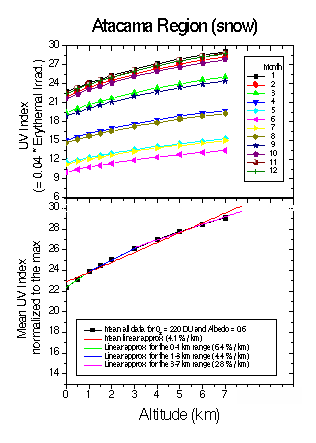
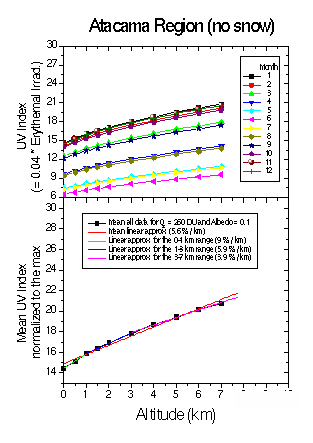
1. Facultad de Ciencias Exactas, Ingeniería y Agrimensura, Universidad
Nacional de Rosario, Argentina
2. Instituto de Física Rosario (CONICET- Universidad Nac. de Rosario), 27 de febrero 210bis, 2000 Rosario, Argentina. e-mail: ruben@ifir.ifir.edu.ar
3. Institute of Medical Physics, University of Innsbruck, Innsbruck, Austria
4. Goddard Space Flight Center/NASA, Greenbelt, MD, USA
5. Facultad de Ciencias, Universidad de Tarapacá, Arica, Chile
FIGURES
In the present work we made detailed radiative transfer model calculations based on the pseudo-spherical DISORT algorithm, of solar ultraviolet irradiances incident over the Atacama desert region around 18º S within a 6º latitudinal interval as function of altitude, from 0 to 7 km, in order to interpolate all possible situations in the region. The resulting irradiances weighted with the erythemal action spectra of McKinlay and Diffey, transformed in UV index through the internationally accepted factor of 0.04 if the first quantity is expressed in mW/m2, are compared with ground based measurements done with a biometer of the SCO3P (Southern Hemisphere Ozone Project)/WMO network at La Quiaca, Argentina, (3459 m a.s.l.), and at Arica (23 m a.s.l. at the Pacific coast) and Copaquilla (3166 m a.s.l.) Chili. The comparison between these measurements and model calculations shows rather good agreement.
UV index for different months of the year are presented, considering typical as well as extreme values of the most significant geophysical variables (ozone, aerosol and albedo for ground surface with and without snow). A mean curve derived from results for all months normalized to the maximum value, gives a slope of 5.6 %/km for no snow and normal ozone conditions and 4.1 %/km for snow (high albedo) and low ozone. In this last case, the absolute value of the erythemal irradiance at the highest mountains picks are within the highest of the Earth. These mean values can be improved significantly if the altitude range is divided in three parts: 0-1 km, 1-3 km and 3-7 km. The corresponding slopes are: 9, 5.9 and 3.9 %/km for the first (normal) case and 6.4, 4.4 and 2.8 %/km for the second (extreme) case.
Also, the yearly variation of this UV index is presented for different altitudes.
Introduction
The Puna of Atacama is a high altitude intertropical very dry
desert region placed on the Andes mountains in the latitude-longitude
range of about (12º - 24º S, 65º - 71º W). Since in the summer
Southern Hemisphere the Earth-Sun actual distance is the lowest
one (it pass at the minimum distance, in the beginning of January),
the corresponding extraterrestrial solar irradiance, proportional
to the inverse square of the ratio of this distance to the mean
one, is 6.4 % higher than the Northern Hemisphere one (see for
example, Iqbal, 1983). Due to all these circumstances, which determine
naturally low intertropical ozone total column and low aerosol
atmospheric content, the global as well as UV solar irradiances
are within the highest in the world (Piacentini and Herman, 1996;
Piacentini and Cede, 2000).
The detailed knowledge of the solar UV irradiance is of great importance in relation to its absolute value in each region of the Earth as well as in order to determine its variation due to ozone and aerosol changes by natural or antropogenic causes (see for example, Herman et al, 2000). Also it is related to different biological and material degradation actions (UNEP, 1998; Zerefos and Bais, 1997).
Table 1. Solar risk qualification for the different ranges of
the UV Index.
|
UV Index |
|
|
|
|
|
|
|
|
|
|
|
|
|
|
|
|
|
|
|
The solar risk measured though the UV index, is directly related
to the erythemal irradiance (in SI units) through the factor 40 (or 0.04 when the common
mW/m2 unit of irradiance is used). This irradiance is obtained
multiplying the spectral solar UV irradiance by the well established erythemal action spectra of McKinlay
and Diffey and integrating the product in the UV (280 nm - 400
nm) range. This action spectra measures the effectiveness of the
incident photons in reddening the normal reference skin and it
is mainly concentrated in the UVB (280 nm -320 nm) range. So,
it is an alarm signal for skin damage (Jagger, 1985). Table 1
gives the relation between the numbers related to the solar UV
Index and the qualification adopted for describing the correspondent
erythemal intensity.
Results
In this work we present results of UVB and erythemal irradiances
incident over the Atacama desert region around 18º S within a
6º latitudinal interval as function of altitude obtained employing
the radiative transfer pseudo-spherical DISORT algorithm. The
ozone total column has a small dependence with latitude in this
region and the global trends produced in the last decades by antropogenic
causes has also very small contribution from this intertropical
region (Bojkov et al, 1999). So an annual mean constant value
has been considered. The other geophysical variables that mainly
influence the UV irradiance is the aerosol total content of the
atmosphere and the albedo (surface reflectivity). The program
automatically adapt the ozone, aerosol and pressure to the corresponding
altitude.
The erythemal irradiance, calculated for each month of the year as function of altitude from 0 to 7 km, a very low ozone layer (the mean minus 2 standard deviations) and for snow and no-snow conditions is displayed in figure 1. It can be seen that the UV index with ground not covered with snow, is systematically lower for each month and altitude than the UV index for snow conditions. Normalizing all curves to the absolute maximum and obtaining the mean value, it is possible to evaluate the mean slope for all altitude or for different altitudinal ranges (see also Tables 2 and 3).
|
|
|
Figure 1. Top: UV Index determined through radiative transfer model calculations for all months of the year and altitude values present in the (18º±6º) S geographical area of the Atacama region at the Andes Mountains for snow (left) and now snow (right) covered surface. This index is internationally defined as UVI=0.04*Erythemal Irradiance in mW/m2. Bottom: yearly mean UV Index increase for different altitudinal ranges, in percent per km.
Table 2. Solar risk UV index slope (in percent per km) for different
altitudes, for the Atacama Region (18º±6º) S and different months of the year corresponding to equinox
and solstice. More common situations are emphasized.
|
|
|
|
||||||
|
|
|
|
|
|
|
|
|
|
|
|
|
|
|
|
|
|
|
|
|
|
|
|
|
|
|
|
|
|
Table 3. Yearly mean of the solar risk UV index slope for different
altitudes, for the Atacama Region (18.5° S). More common situations
are emphasized.
Altitude range |
|
|
|
|
|
|
|
|
With snow |
|
|
|
A verification of the calculated values can be made comparing
these values with those measured at La Quiaca (3459 m asl), Argentina
with a YES biometer (figure 2) and at Arica (23 m asl at the Pacific
coast) and Copaquilla (3166 m asl), Chili using an IL 1400 A biometer
(see Tables 4 and 5). Kondratyev and Varotsos (2000) presented
results of erythemal irradiance measured with a UV-501 Solar Light
biometer over Athens, Greece on June 1997. Even if they were obtained
in a region of the Earth with different atmosphere and surface
albedo, the data show the same qualitative "saturation to high
altitude" behavior as the present calculations.
Table 4. Percentage variation of erythemal irradiance (directly
related with the solar risk) measured with an IL1400A instrument
at horizontal plane around solar noon in Copaquilla (18.40º S,
69.65º W, 3166 m a.s.l.) and in Arica (18.47º S, 70.31º W, 23
m. a.s.l.), Chili and comparison with the results of calculations
with radiative transfer model in "no snow" case for December month
(see figure 2). Both results are within error bands.
|
RESULT OF |
|
|
|
|
|
|
|
Table 5. UV Index (solar risk) determined at La Quiaca (22.11º
S, 65.57º W, 3459 m a.s.l.), Argentina through the measurement
of the erythemal irradiance done with a YES UVB-1 biometer of
the SCO3P (Southern Cone Ozone Project)/WMO at solar noon on February
20, 1999 compared with model result (see figure 2). Both results
are within error bands and correspond to Extreme qualification
|
RESULT OF |
|
|
|
|
|
|
|
Results for very high altitude conditions like the top of the
Parinacota volcano (Atacama desert, Andes mountains, 6342 m asl)
for all months in snow ground conditions are described in Table
6. During all months the values are in the Very High or Extreme
ranges.
Erythemal irradiances for consecutive days are given in figure
3 for normal mean ozone and low and high albedo.
Table 6. UV Index (solar risk) at the pick of Parinacota volcano
(Atacama desert, Andes mountains, 6342 m a.s.l.) for all months
in snow ground conditions. Note that during all months the values
are in the Very High or Extreme ranges.
|
|
|
|
|
|
|
|
|
|
|
|
|
|
|
|
|
|
|
|
|
|
|
|
|
|
|
|
|
|
|
|
|
|
|
|
|
|
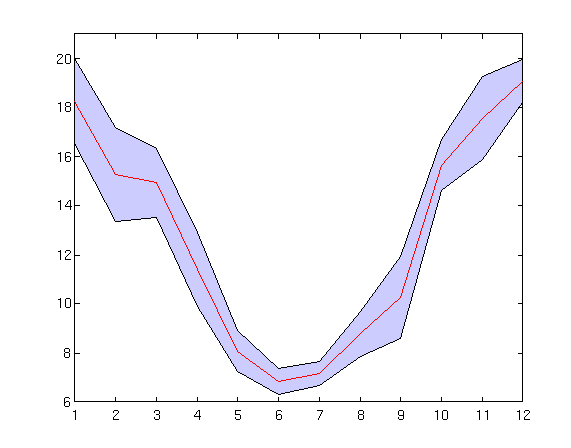
Figure 2. UV index determined from erythemal irradiance measurements done with the biometer of the SCO3P (Southern Hemisphere Ozone Project)/WMO network at La Quiaca, Argentina (3459 m asl). Mean of the last 3 years clear sky maxima plus and minus one standard deviation.
Figure 4 shows the UV index for the Southern Hemisphere solstice
and equinoxes and the day of the maximum observed irradiance at
all altitudes (January 29).
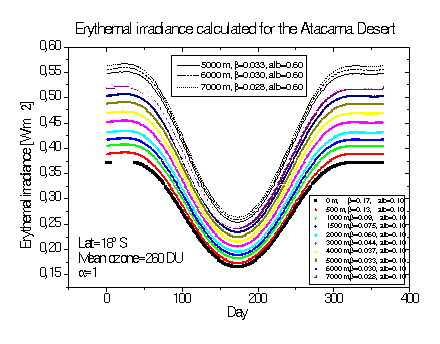
Figure 3. Erythemal irradiance calculated for the Atacama desert region for consecutive days, considering normal mean ozone (260 DU) and low (0.1) no snow and high (0.6) snow albedo, the last one at high altitudes (between 5 and 7 km).
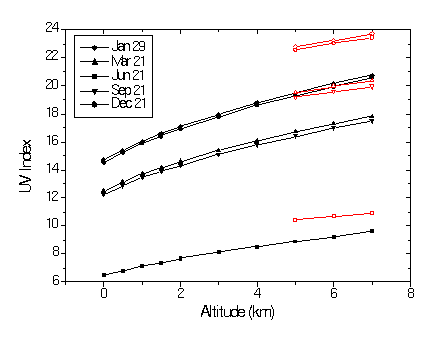
Figure 4. Solar UV index for the Atacama desert region as function of altitude, for Southern Hemisphere solar solstices and equinoxes and the day of maximum absolute UV irradiance at all altitudes (January 29). Values for mean normal ozone (260 DU) and albedo (0.1) are given as black curves and high albedo (0.6) corresponding to snow at high altitudes (5 to 7 km) are given as red curves.
Conclusions
In spring and summer, extreme values of the UV index, larger by
a factor of two with respect to those registered at mid-latitudes
near sea level, were determined for this very dry and desert high
altitude region of Atacama, and verified at particular locations
and periods of the year. Even in autumn and winter, rather high
values of this index are common. Persons that live permanently
there or that spend some periods of the year, must implement measures
for protecting their skin and eyes.
Acknowledgements.
This work was partially financed by ANPCyT (Agencia Nacional de Promoción Científica y Tecnológica) of Argentina, FOMEC (Fondo para el Mejoramiento de la Enseñanza Universitaria, Ministerio de Educación de la Nación), Universidad Nacional de Rosario, Universidad de Tarapacá, Chile, Servicio Meteorológico Nacional de Argentina and CONICET. The technical computational assistance of Pablo García at the Astronomical Observatory of Rosario, Argentina, is kindly appreciated.
Bojkov R. "Ozone variability and trends" in "Scientific Assessment of Ozone Depletion: 1998". WMO Report 44, chapter 4, 1999.
Herman J, Piacentini R D, Ziemke J, Celarier E and Larko D. "Interannual variability of UVB radiations". Journal of Geophysical Research, in press (2000).
Iqbal M. "Introduction to Solar Radiation", Academic Press, 1983.
Jagger C. "Solar UV Action on Living Cells". Praeger, New York, 1985
Kondratyev K Ya. and Varotsos C. "Atmospheric Ozone Variability. Implications for Climate Change, Human Health and Ecosystems". Springer, Berlin, 2000.
Piacentini R D and Cede A. "Very high solar irradiance at Puna of Atacama desert", submitted for publication, 2000.
Piacentini R D and Herman J. Energías Renovables y Medio Ambiente (in spanish). 1, 6, 1996.
UNEP Report "Environmental Effects of Ozone Depletion". Published in the special issue of Journal of Photochemistry and Photobiology B: Biology. 46, Numbers 1-3, 1998.
Back to
| Session 1 : Stratospheric Processes and their Role in Climate | Session 2 : Stratospheric Indicators of Climate Change |
| Session 3 : Modelling and Diagnosis of Stratospheric Effects on Climate | Session 4 : UV Observations and Modelling |
| AuthorData | |
| Home Page | |